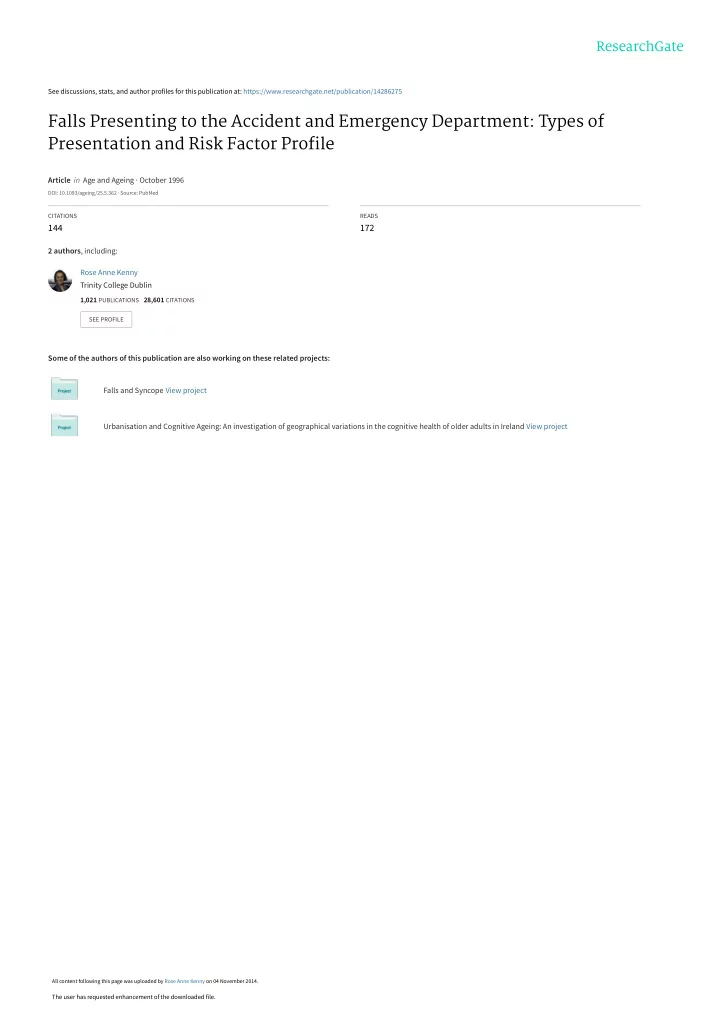

See discussions, stats, and author profiles for this publication at: https://www.researchgate.net/publication/14286275 Falls Presenting to the Accident and Emergency Department: Types of Presentation and Risk Factor Profile Article in Age and Ageing · October 1996 DOI: 10.1093/ageing/25.5.362 · Source: PubMed CITATIONS READS 144 172 2 authors , including: Rose Anne Kenny Trinity College Dublin 1,021 PUBLICATIONS 28,601 CITATIONS SEE PROFILE Some of the authors of this publication are also working on these related projects: Falls and Syncope View project Urbanisation and Cognitive Ageing: An investigation of geographical variations in the cognitive health of older adults in Ireland View project All content following this page was uploaded by Rose Anne Kenny on 04 November 2014. The user has requested enhancement of the downloaded file.
Age and Ageing 1996:25:362-366 Falls Presenting to the Accident and Emergency Department: Types of Presentation and Risk Factor Profile A. J. DAVIES, R. A. KENNY Summary The aim of this study was to evaluate the type and frequency of falls presenting to an inner city casualty department, and to identify modifiable risk factors in these patients. A prospective descriptive study evaluated those over 65 years presenting to an inner city casualty department with falls. Over a 4-week recruitment period, all consenting subjects completed a semi-structured questionnaire regarding their falls and cognitive status. Those with unexplained (UF) or recurrent falls (RF) underwent a more detailed assessment: history and examination, gait and balance assessment, visual acuity measurement and neurocardiovascular investigations (including orthostatic blood pressure, carotid sinus massage and head-up tilt testing). Downloaded from Of 200 patients with falls, 188 were interviewed; 29% could recall a reason for falling (accidental) and 30% had UF or RF. A cohort of 26 cognitively normal patients with UF and RF was fully investigated. In 23/26 patients risk factors for falls were found (median: three risk factors). These included: culprit medication (10), gait ageing.oxfordjournals.org abnormalities (9) and carotid sinus hypersensitivity (19). Falls are a common presenting complaint yet a fall is readily explained in less than one-third of cases. Investigation of RF and UF has a high yield for possibly modifiable cardiac and non-cardiac risk factors. Targeted multi-disciplinary rapid assessment of patients attending the Accident and Emergency Department because of a fall might reduce the number of hospital admissions. by guest on July 12, 2011 Keywords: Carotid sinus hypersensitivity, Falls, Accident and Emergency, Modifiable risk factors. have not been evaluated in the UK. In 1991, a King's Introduction College Institute of Gerontology report suggested that Falling in elderly people is a common problem. The although the management of injury in A&E was good, annual incidence of falls in those over 65 years living in there was no generally agreed policy on elderly people the community has been reported consistently to be with falls and that subsequent investigation of fallers between 28% and 35%; this increases to in excess of 40% was less than adequate [10]. for those over 75 years [1, 2]. The objective of this study was to characterize falls in Falls result in psycho-social and physical morbidity, elderly patients presenting to an A&E and to characterize i.e. restrictions in activities of daily living [3], changes modifiable risk factors for fallers. in health status [4], nursing-home placement; social isolation [5], increased hospitalization [6] and increased Method mortality [7]. Ten per cent to 15% of falls result in serious injury. In the UK, 34% of admissions to All patients who presented with a fall to A&E of the Royal hospital from the Accident and Emergency Depart- Victoria Infirmary during a randomly assigned 28-day period in August and September 1994 were screened. A fall was ment (A&E) are as a direct result of a fall [8] and 25% of defined as 'inadvertently coming to rest on the ground or these patients have a prolonged hospital stay [9]. other lower level with or without loss of consciousness' [7]. Falls are a common presenting complaint to A&E. Fallers were initially screened for cognitive impairment Many units are now setting up guidelines for the (10-point mental test score) and those who scored < 10 were management of falls in this setting, yet little is known evaluated more fully using the Folstein mini-mental state either about the clinical characteristics of falls in elderly examination (MMSE) [11]. Those who scored less than 25/30 patients who present to A&E or the benefits of risk factor on MMSE were classified as cognitively impaired, deemed modification. Guidelines for risk factor modification inappropriate for classification of falls according to history
Recommend
More recommend